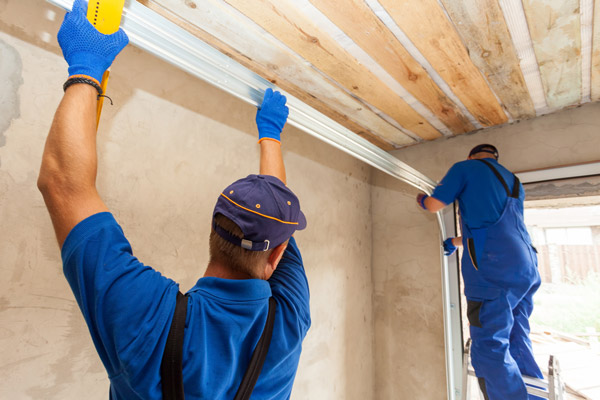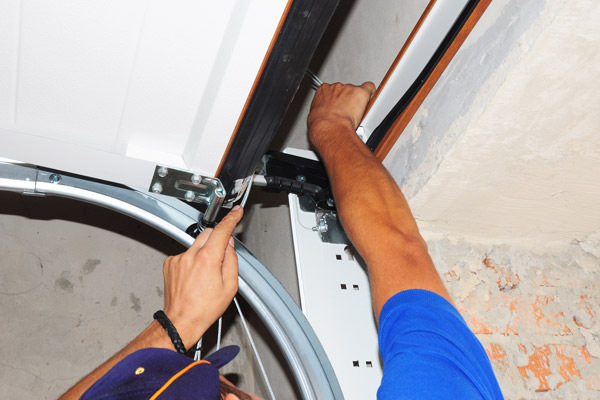Troubleshooting Faulty Garage Door Springs
Many people often use their garage door more than the front door. It serves as a primary entry and exit point for your vehicle. Your garage door is raised and lowered several times per day, an action you usually take for granted as you push a button on your way in or out.
If one day your garage door doesn’t not open or it’s no longer simply pressing a button and backing out. You now have a problem and must find a solution. While there could be several causes for a broken garage door, one likely is a broken or faulty torsion spring.
If your home has a garage, you must understand the mechanics of your door so that you can quickly identify a problem. As a result, you’ll have an easier time determining who to call this way, and your door will be operational at full capacity sooner.

What Is a Garage Door Spring?
The garage door spring is on the top of the door inside your garage. It’s significant and obvious. It is connected to cables that easily end up when the garage door opener is turned on; your automatic opening system depends on where these cables are and how they work. This spring is critical to the proper operation of your garage door. As the cables turn, the tension on the spring increases, causing the door to rise. If it is broken or damaged, it will not function properly, resulting in a door that does not open properly or at all.
Garage door springs should be long-lasting. They should last 10,000 cycles of opening and closing your garage door. They may, however, deteriorate or wear out over time, just like anything else. In a perfect world, homeowners would call a reputable garage door repair company to service their garage door springs. Although this service does not need to be done regularly, it is important to keep an eye on how your door operates and maintain it properly as it ages.
The good news is that the springs are the most likely to break fall the parts on a garage door, making diagnosing problems easy. The bad news is that a broken garage door torsion spring can become a safety hazard. So, if your door isn’t opening properly, the first thing you should check is the condition of your spring, especially if your door is getting old and you haven’t had it serviced in a while.
Signs of a Faulty Garage Door Spring
If your door isn’t opening properly, inspect it for a few minutes to see if you can pinpoint the issue. Your spring might be worn out or damaged, but it won’t be broken. However, at times, there will be a clear break. It is not difficult to determine that your garage door spring is compromised.
Below are common signs for identifying damaged or worn-out springs:
Issues With Balance
Your door may be out of balance if it is difficult to close and open while still moving. You can also tell if this is a problem if your door suddenly drops after rising a few inches or if it moves up and down on the path more slowly than usual. It may become faster or slower depending on what caused it to become unbalanced. Excessive noise as you raise and lower it is another telltale sign of balance issues.
A problem with the spring doesn’t always cause issues with the garage door balance, but it can aggravate an existing problem or cause one if you continue to use the door despite balance issues. If you don’t address the alleged balance issues, they can eventually put extra strain on the spring, causing it to break or damage.
Excessive Screeching
This is one of the most common problems you will encounter with a garage door. Whether your door is manual or automatic, the springs are metal components that require regular oiling. Lubricating garage door springs is a messy but necessary part of garage ownership. You should perform this task yearly or contact your garage door installer for routine maintenance.
You can do this every six months if you have a noisy component or two. However, if you choose biannual oiling, experts recommend cleaning and lubricating the door after the last freeze and every fall. This allows you to remove salt crystals and prepare your door for spring rains, while the fall lube ensures that your door works properly throughout the colder months.
Door Does Not Remain Open
Did you know that the springs do nearly all the lifting when you open and close your garage door? You can look for signs that your door is experiencing tension issues by observing how it opens and closes. If the door does not stay open, you have a tension problem that needs to be addressed. On the other hand, if your door only opens a few inches before stopping, your spring is most likely broken rather than loose.
Deterioration of the Garage Door Components
Check the various parts of your garage door for damage or deterioration while inside the garage with the door closed. For example, look for damage or wear on the garage door springs, mounting hardware, pulleys, cables, and rollers. Even if the springs appear in good condition, damage to other components puts more strain on the rest of the garage door, increasing the likelihood that your springs will be damaged.
Troubleshooting Your Garage Door Spring
More often than most people realize, checking and troubleshooting your garage door spring is crucial. The garage spring is a small but important component: they do 90% of the lifting when an automatic opener is used.
However, they can lose tension over time, causing the motor to work harder than necessary. When the motor is overworked, the plastic gears inside can break, and your garage will no longer open automatically.

Follow the tips below to troubleshoot your garage door spring.
- Check that the door is closed (NEVER disconnect anything on a garage door if it is partially open).
- Pull the red emergency release cord down. This detaches your door from the motor.
- Raise the garage door up halfway to the middle point. However, if it feels heavy, do not let go – it may come crashing down.
Otherwise, open the door. It should remain in this middle position and not move up or down. This means it’s balanced, which means the spring and the automatic opener are functioning correctly.
- Continue by raising the garage door to shoulder height. When you let go, it should rest as it did in the previous step.
If the door moves after you release your grip, the spring is likely faulty and should be replaced.
However, this isn’t always the case: a minor adjustment to the motor’s force could solve the problem. For example, slightly reducing the force may improve the tension of the spring. You can do this at home, but you’ll need to know how much force to apply (the amount is specified in your user’s manual). The safety reversal system must then be tested.
We recommend contacting a garage door technician if your spring is compromised. By hiring a specialist, you can avoid costly repairs. Often, the specialist can tighten the spring to increase tension, avoiding the need for a full repair.
Before needing replacement due to faults, a typical garage door spring should last seven to twelve years. Two times a year, lubricating the garage door’s parts with a small spray lubricant can help lessen the chance of garage door spring damage.
If possible, check your garage door for signs of broken or faulty springs monthly. Schedule a professional garage door inspection if you notice these signs. Never try to repair or replace garage door springs yourself. Because of the tension in the springs, incorrect handling can result in serious injury.
That’s why Danley’s Garages is #1 in Chicagoland for detached garage construction. Speak to a specialist and get a free quote today.





